Ceramic crowns
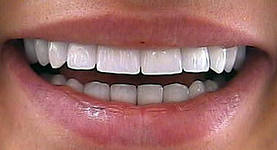
Metal-free ceramics is one of the modern types of dental prosthetics. A design feature is the fact that it is created from a very durable ceramic material.
Metal-free ceramics is the most popular type of prosthetics when it is necessary to solve the aesthetic problems of front teeth. Metal-free ceramic prostheses cannot be distinguished from real teeth, therefore this type of ceramics is recommended to singers, artists.
Currently, thanks to new technologies for the manufacture of ceramic structures, which have high strength, non-metal ceramics for chewing teeth has become popular.
Ceramics is a biologically harmless material; there is no allergy to it.
Classification and types of non-metal ceramics
Non-metal structures can be:
- All-ceramic (porcelain).
- Whole zirconium (zirconium oxide, zirconium dioxide).
- Dental crowns on a zirconium frame, lined with ceramic mass.
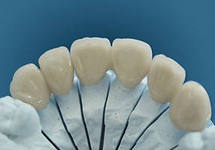
Metal-free ceramics are a success, especially where highly aesthetic restoration of teeth is required. Restoring a damaged tooth crown is best done with ceramic or zirconium inlays. They have high strength, transmit light well enough and are close to the natural shade of the teeth.
Whole-zirconium designs for teeth not so long ago in the arsenal of dentists, but have already managed to take a leading position. They are very durable. Ideal for facing the front teeth, in order to hide existing defects, as well as protect tooth tissue from wear. Zirconia designs can be mounted on chewing teeth.
All-ceramic dental crowns are very hard and can burst easily due to stress. They are recommended to be installed on the front teeth, where the load is not very large.
Production of ceramic crowns
For the manufacture of ceramic dental crowns, at present, technologies such as:
- CAD / CAM (computer simulation). This is the process of manufacturing tooth structures made of zirconium, in which the calculation of the size of the crowns is carried out using a computer, and manufacturing, according to the results obtained, with the participation of machine tools with program control.
- Press casting method (IPS e.max) and porcelain layering.
- Electrotype.
CAD / CAM modeling steps
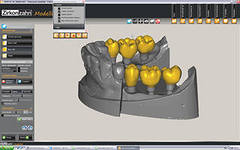
- Taking a mold from the patient's jaw.
- The system scans the impression and sends the data to the computer. The computer, using a special program, builds a virtual simulation of the future design in the form of a three-dimensional electronic model.
- Making a prosthesis on a machine with high-precision automatic systems. A milling machine cuts a frame from zirconium dioxide, which is burned in a special furnace.As a result, the zirconium framework acquires the strength of the metal.
- A dental technician applies layer-by-layer porcelain to a zirconium frame. Each applied layer is also sintered in the furnace.
- Before the last firing, the crown is stained with dyes.
- Structures made in this way do not require any turning or any adjustment.
Indications
Metal-free ceramic has the following indications for installation:
- Lack of one or more teeth.
- Defects in the teeth and dentition.
- Unaesthetic appearance of the front teeth.
- Restoration of damaged teeth.
- Alignment of the dentition.
Contraindications
Prosthetics with non-metal ceramics is contraindicated in:
- Acute systemic diseases of the body.
- Inflammatory processes of the oral cavity.
- A weakened body after a disease.
- Pregnancy
- Severe osteoporosis.
Video »Metal-free ceramics»
How is the installation
Before installing the prosthesis from non-metal ceramics, the doctor treats the tooth, removes poor-quality fillings, etc.
Dental prosthetics with non-metal ceramics takes place in several stages:
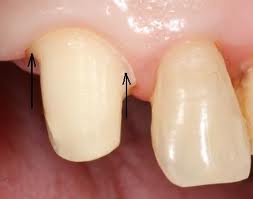
- The tooth is turned to the thickness of the crown.
- Taking impressions from the upper and lower jaws of the patient.
- Temporary crowns are made of plastic and fixed using temporary cement.
- Matching the color of the tooth structure.
- In the laboratory, using computer simulation, the manufacture of structures from non-metal ceramics is carried out.
- Trying and fixing non-metal ceramics to permanent cement.
Recovery and rehabilitation
After installing metal-free ceramics, the following problems may occur:
- Poor tooth shape.
- Crown color mismatch with the tone of real teeth.
- Poor marginal fit.
- Soreness due to mismatch in the size of the structure.
To avoid complications, it is necessary to follow the recommendations of the dentist and undergo a routine examination at least twice a year.
FAQ
Often patients can not decide on the choice of designs for teeth. When choosing dental prosthetics, it is necessary to take into account the condition of the teeth, as well as the oral cavity.
Particular attention should be paid to the presence of indications and contraindications for the installation of the structure. To make it easier to make a choice in favor of a particular prosthesis, the answers of specialists to frequently asked questions will help.
- Question: How durable are ceramic crowns?
Answer: The strength of ceramic crowns depends on the material from which they are made. Porcelain dental structures are strong enough, but they are not recommended to be placed on chewing teeth, because they are very hard and the design may not withstand chewing load. Zirconium crowns are very durable and can be installed on both front and chewing teeth.
- Question: What is still better than cermets or non-metal ceramics?
Answer: Metal-free ceramic crowns are more aesthetic than metal-ceramic crowns. But they are more expensive. Ceramic-metal constructions are as durable as those made of zirconium. There are no allergies to metal-free prostheses. Non-metal ceramics, as well as cermets, have their advantages and disadvantages.
- Question: What determines the high cost of non-metal ceramics?
Answer: The cost of manufacturing ceramic dental structures depends on the cost of the material and the complexity of its processing. The production of ceramic prostheses requires expensive equipment and qualified personnel.
Pros and cons
Advantages of dental structures made of non-metal ceramics:
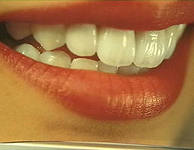
- A very high level of aesthetics. Ceramic crowns on teeth are outwardly identical to real teeth. The properties of ceramics make an artificial tooth or crown indistinguishable from other teeth.
- Metal-free ceramic crowns fit perfectly to the gums, there is no gray strip at the border.
- Durability and reliability. Structures made of non-metal ceramics are able to maintain color for a sufficiently long period of time.
- Biological compatibility of ceramics with tissues of teeth and gums. Hypoallergenicity.
- High cushioning ability of ceramics allows you to remove the load from the periodontium.
- Strong tooth preparation for non-metal ceramics is not required.
- Quick getting used to the prosthesis due to the lightness of the material.
- There is no gum irritation.
The disadvantages of ceramic designs for teeth:
- The choice in the material is limited. Only zirconium is suitable for the manufacture of chewing teeth designs. For the manufacture of individual crowns, both zirconium and porcelain are suitable.
- The high cost of dentures.
Care for ceramic crowns
The care for dental structures made of non-metal ceramics should be the same as the usual care for your teeth:

- It is important to carry out daily hygienic care of the oral cavity with the obligatory brushing of the teeth with a toothpaste brush.
- After eating, it is recommended to carefully remove food debris at the place where the tooth comes into contact with the gums and from the interdental spaces. After eating, it is necessary to rinse the mouth with water or a special mouth rinse, using dental floss to clean the spaces between the teeth.
- To care for non-metal ceramics, toothpaste with a high degree of abrasion is not recommended.
- It is not recommended to crack hard objects (nuts, ice, seeds, nails, etc.).
Compliance with the above requirements will allow you to have beautiful ceramic crowns, the service life of which can be increased.
Prices for non-metal ceramics
When restoring teeth using non-metal ceramics, the cost of installation is determined by a number of factors:
- Dental prosthetics.
- Type of construction.
- The material used to make the prosthesis.
- Scope of work on the manufacture and installation of the structure.
| Type of crown | Price (in rubles) |
| Porcelain crown | From 13000 |
| One tooth temporary plastic crown | 1000 |
| Zirconium oxide crown | From 16000 |
| Cermet crown | From 4500 |
Metal-free ceramics are a rather expensive type of dental prosthetics. Porcelain or zirconia ceramic crown, the price of which is several times higher than for cermets is able to convey the natural beauty of the restored tooth.
Reviews after installation
Today it is possible to replace one or more teeth, while their aesthetics and functionality are fully restored. Modern technologies allow patients to restore their lost teeth appearance using non-metal ceramics.
Patients who chose non-metal ceramic tooth crowns are pleased with the result.
Here are some reviews of patients who installed metal-free ceramic crowns on their front teeth:
- After treatment of the front tooth, a nerve had to be removed. After a while, the color of the tooth changed and began to differ from those nearby. Agreed to put non-metal ceramics. The color of the teeth is now no different. I can smile without problems.
- On the front teeth was cermet. But friends noticed that the teeth are not real. I went to the dentist. The doctor advised to put non-metal ceramics. Now no one knows that my teeth are covered with crowns.
- There was a problem with the front teeth. The presence of fillings that did not match the color showed that the teeth were diseased. I changed the seals, anyway, the result did not suit me. The dentist suggested putting crowns made of non-metal ceramics. The result is amazing! Very satisfied.
Photos before and after installing ceramic crowns
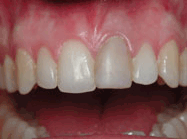 |
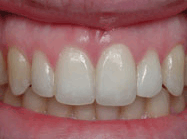 |
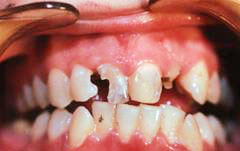 |
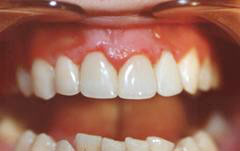 |
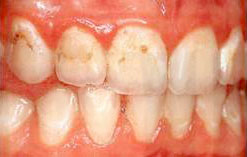 |
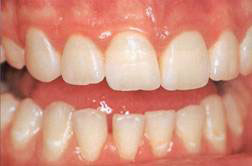 |
